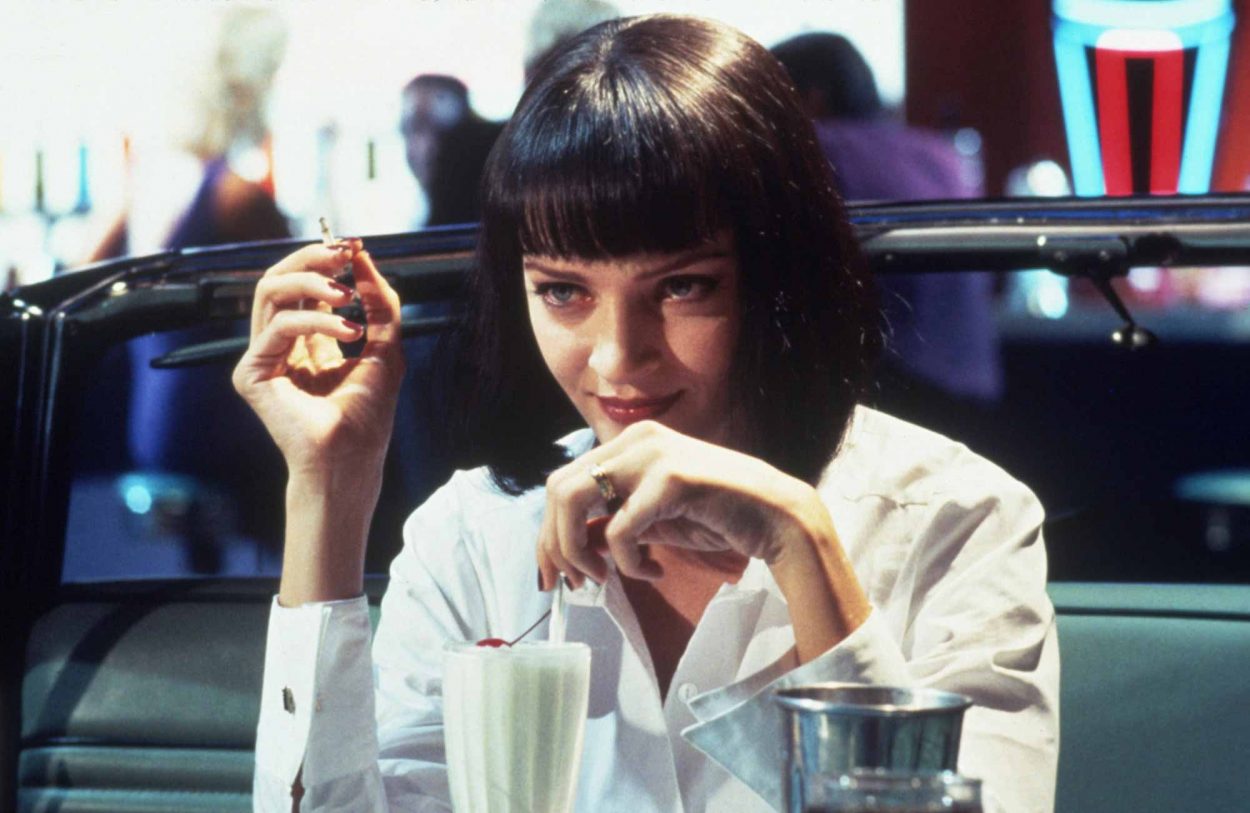“Shelley did it superbly, with perhaps the thought of her own daughter contributing to the sense of loss and horror she conveyed as the girl’s mummified body crumbles in her hands.” – Curtis Harrington
Auntie Roo is a sad woman. And Christmas would be dismal without the children. Not her children, but the children, the orphans. So, the children must visit. And Auntie Roo must entertain. She will shower the kids with presents and fill them up with treats and laugh and sing and it all sounds so sweet. And some of her loving generosity is sweet but … Auntie Roo is not well. She is, in fact, dangerous.
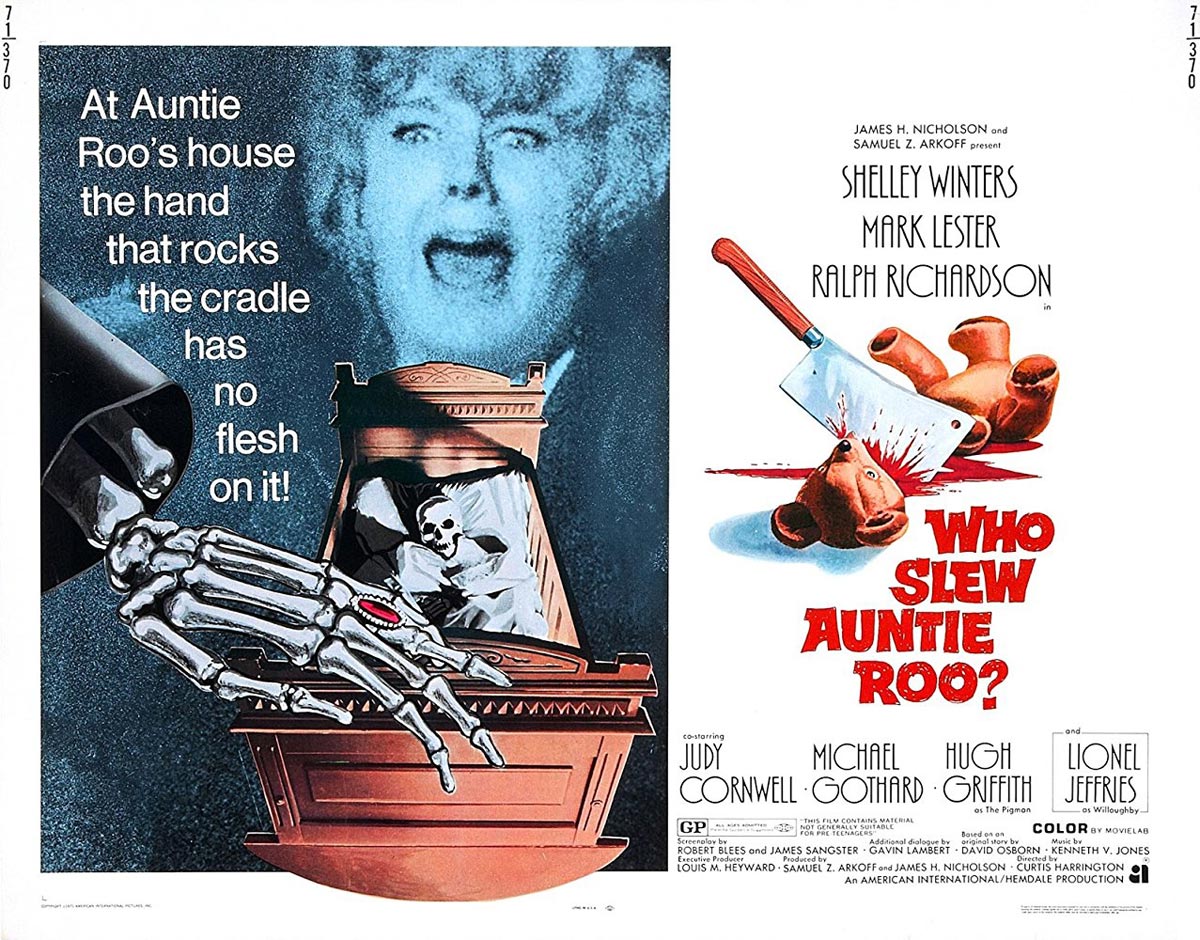
And yet, we don’t dislike Auntie Roo. Not entirely. As Shelley Winters plays this disturbed, lonely lady in Curtis Harrington’s dreamy-creepy Whoever Slew Auntie Roo?, we can only feel sorry for her, no matter how crazy and, at times, terrifying she is – snatching children, screaming for her dead daughter, tending to a mummified corpse… Yes, that’s right. Tending to a mummified corpse. We should be scared of her, perhaps even disgusted by this freaky soul, but we’re more perplexed and intrigued. And importantly, we (or rather, I) have sympathy for her. Much of our sympathy has to do with director Harrington’s sensitivity and insight towards the addled woman at the center of this dark fairy tale, and much of this has to with the performance of a brassy, bereaved Shelley Winters. She is wonderful here – weird, lonely, irritating, vulgar, funny, pathetic and very human – Winters fleshes out what could have been a one note crazy person with almost embarrassing vulnerability.
Winters always had a very specific quality of a wounded obnoxiousness that was very much her own, and in certain roles, it could alternate from whiny and pathetic, to irate psycho, to hilarious dame within seconds. No one whines like Shelley Winters (“Ohhh…. I’m lonely!” she moans to Humbert Humbert). Her whining is funny and mortifying and sad and you cringe because it’s just so nakedly needy. You want her to stop and yet her timing is so perfect, you wince, and then you want her to continue. Continue the annoyance, Shelley! At times, she plays aggressively needy to the point of dominance. Like she knows she’s being irritating and does not give a shit – like she’s actually getting off on how annoying she is. In her most pitiful roles, she could feel suffocating to her co-stars and even to the viewer (think George Stevens’ A Place in the Sun), and we feel simultaneously terrible for wishing she’d go away and for her really, truly going away (in the case of A Place in the Sun – tragic Shelley dies). We can’t stand her, and then the poor woman does something or has something done to her that breaks our heart. Winters showcased a complexity and depth that went beyond “the cow…the obnoxious Mama…the brainless baba…” (as James Mason’s Humbert wrote of her in Stanley Kubrick’s Lolita). And she was brave to play such braying, potentially unlikable parts. Brave to be dumpy, brave to be annoying, brave to be braying.
And she’s often given such little honor in her more piteous performances, which makes her watery death in Charles Laughton’s Night of the Hunter so poignant, both narratively and stylistically. Shelley is snuffed out, but she is composed in such a hauntingly beautiful shot, that liquid submersion, that Laughton granted her one of the most lyrical deaths in all of cinema. There she is sitting in her watery grave – her hair waving with the seaweed. It’s transcendent.
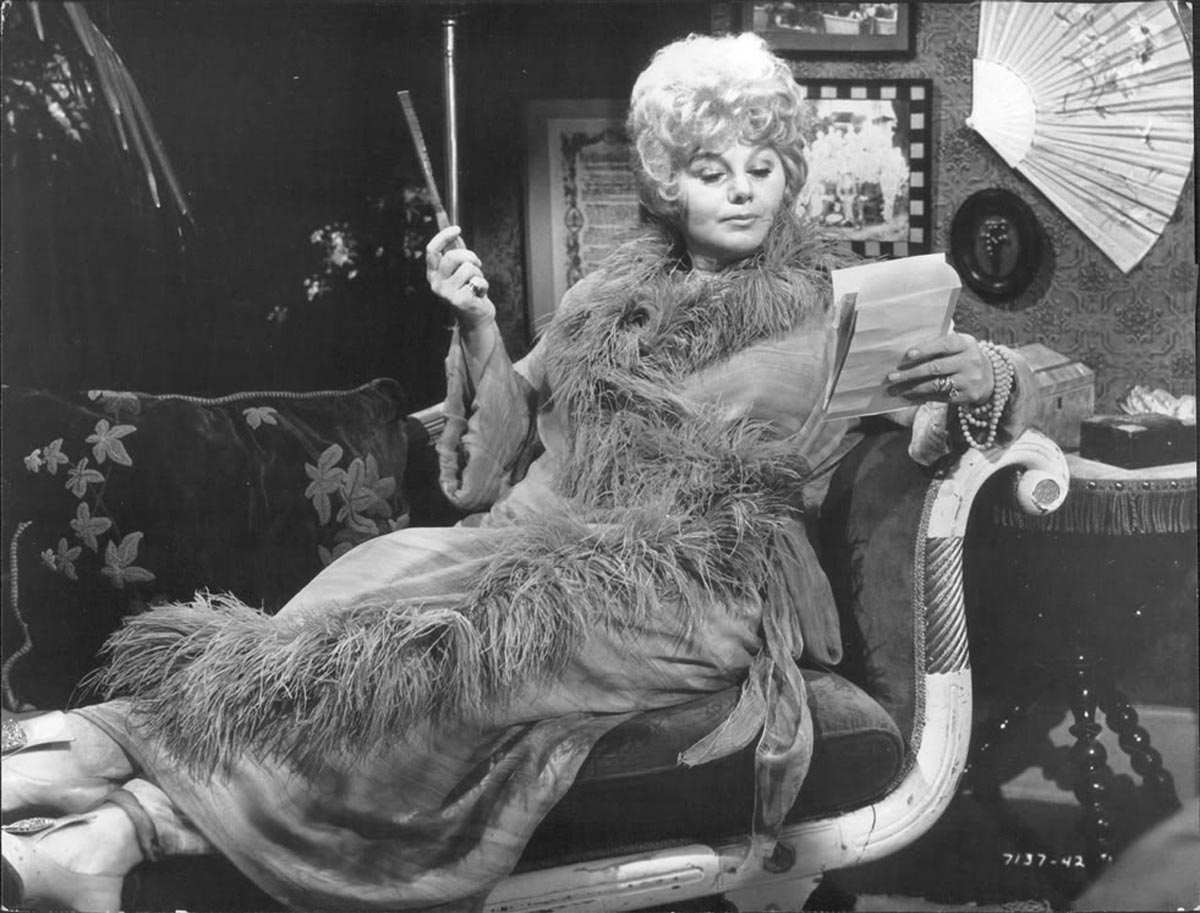
In Whoever Slew Auntie Roo? (set in Edwardian England) she is not afforded such beauty in death, but it’s not an ugly death and we’re not, in fact, hoping she will die, which is interesting. And the moment she’s on screen, we’re curious about her character right away, ready to see what Shelley will do next. Will she complain? Cry dejectedly? Yell at a man? No, her first moment is quite gentle – she is singing, and with nary a whine. Decked out in a maroon gown, a diamond tiara, a diamond necklace, and long white gloves, the sparkling, though faded and melancholic Rosie Forrest (a.k.a. Auntie Roo) sits next to a child’s crib alone, singing the British and Irish Folk song, “Let No Man Steal Your Thyme.” This surely wasn’t just some song Harrington plucked out for old time affect – it seems intentional in tune and lyrics. A song notable for its haunting refrain of “thyme” – a doubling that means your virginity or your purity, or a way of expressing time… Let no man steal either one:
“Come all you fair and tender maids That flourish in your prime. Beware, beware keep your garden fair. Let no man steal your thyme; Let no man steal your thyme. For when your thyme is past and gone, he’ll care no more for you, and every place where your thyme was waste, will all spread o’re with rue, will all spread o’re with rue. For woman is a branchy tree, and man’s a clinging vine, and from your branches carelessly, he’ll take what he can find, he’ll take what he can find.”
Will spread o’re with rue… Roo?
There doesn’t seem to be any suitors for Rosie nor does she appear to want one. No man will steal her time. Oh, but the right child – that is different. And it’s not like the world wants Rosie in that way anymore, which is a shame (she’s often fabulous), but the world isn’t a kind place to aging women in mansions who… dance, hold séances, wriggle into costumes for entertainment and, well, bray. Her husband, a magician, is gone forever (she’s a widow), and she lives in an enormous home favored by the town’s children of the town for looking like a gingerbread house. It’s a cheerful place, it would seem, but it’s really not at all – it’s shadowed with death and decay. You see that in the first scene too. After Auntie Roo sings the pretty but ominous tune, she peers into the crib to view a young blonde girl – a delusion – that’s what she thinks she sees (or wants to see). In actuality, it’s the mummified corpse (it had to be said again) of her dead daughter – a dusty gross thing she will place in a coffin. In a dreamy black and white flashback shown later in the picture, we see that her darling daughter suffered a tragic accident on the staircase banister – which seems absurd and almost funny but it’s told with such a fever-pitch of “Oh my god!” that it works. This needless tragedy has made the poor woman lose her mind, and you can understand why, though her methods of remembering the dearly departed are obviously troubling.
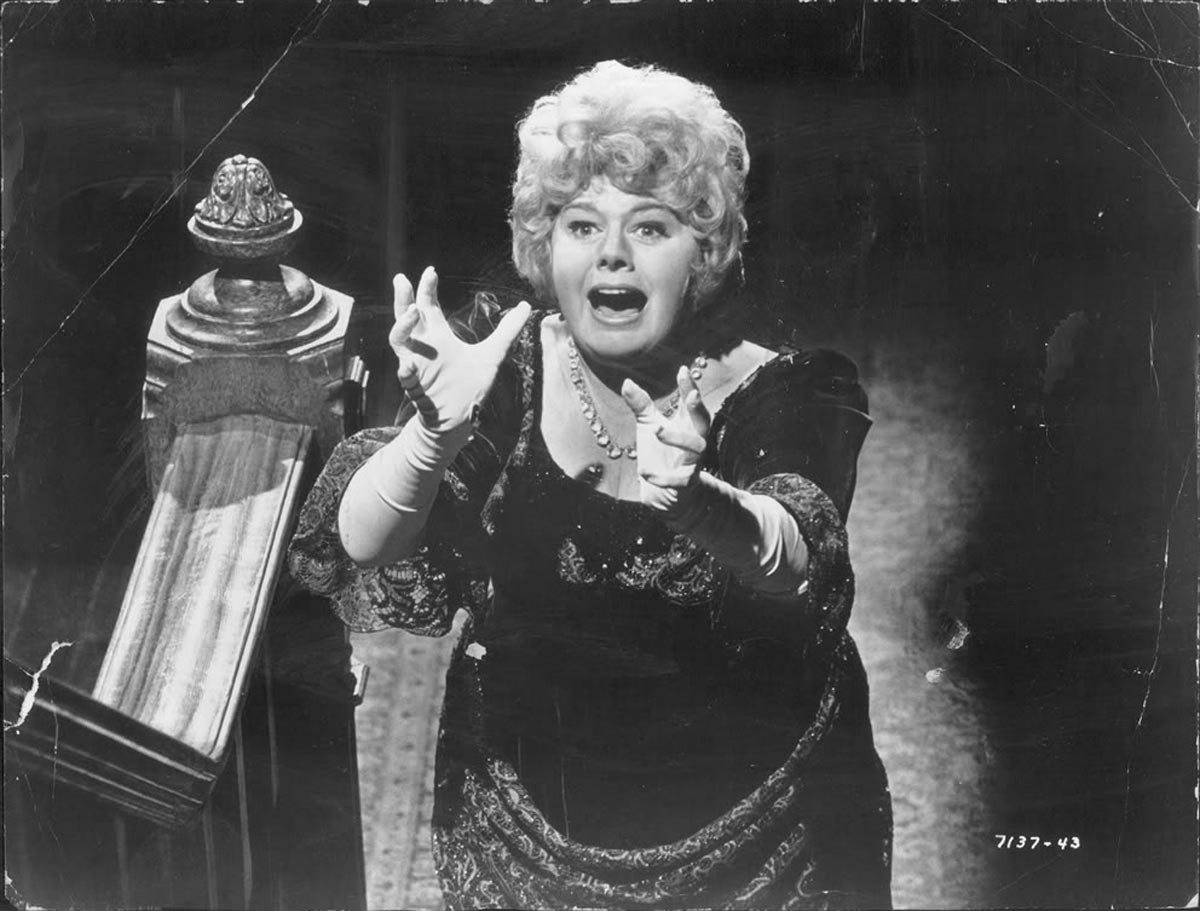
But back to that mummified corpse – the picture presents the revelation as a shock but somehow it doesn’t play like one – not to me anyway. I think, what else would Auntie Roo be singing to? As the picture surveys the creepy room with its dolls and stuffed animals (shot by cinematographer Desmond Dickinson, whom Harrington wasn’t pleased with – you can see how a moodier look would have been preferable and the cinematography hampers the film a bit) a corpse is not a stretch – even in the first scene. And this could be to the picture’s detriment, but it’s not. The movie works more as a character study and less as a horror movie (which viewers likely expect), or even as a straight-up psycho-biddy – a.k.a. movies in which aging actresses go insane, commit murder or serve rats for lunch. The psycho biddy, hagsploitation or the more preferable, respectful term – Grande Dame Guignol – is a genre I love, no matter how varied the quality of pictures are among them. Some are borderline exploitative, some quite sensitive, but most are full of intriguing insights and psychodrama with fantastic, operatic performances by actresses – movie stars— who don’t just chew the scenery, but tear up the screen, bravely showcasing the unfair horror of aging from a perspective of such intense female fear (and male sexism) that some of these pictures border on the surreal.
My god, it should not be so scary to age, but in Hollywood, that kind of fear twists into the darkest places imaginable, both absurd and entirely believable. There’s an uneasy feeling to some Grande Dame Guignol – that the films are seeking revenge on such beautiful stars, that audiences, and particularly men, enjoy watching such iconic beauties looking so ravaged and crazy. That they love to see the mighty fall. I love watching them, not because of faded beauty, but because the women are powerhouses and still striking and electric on screen. To me, these actresses are so fearless, so charismatic, and interpreted these parts with such specific style and soul (if we count this movie as one of the first – Gloria Swanson – in Billy Wilder’s Sunset Blvd. is truly her own work of art – and still gorgeous, I might add), that I can only look at their visages with respect and sometimes awe. Shitty men reveling in their demise? I don’t know except, fuck that and fuck those guys. One should admire these actresses for taking these parts and never coasting, giving these films their all (like Joan Crawford in William Castle’s incredible Straight-Jacket). Bette Davis and Joan are the Grande Dames in Robert Aldrich’s Whatever Happened to Baby Jane? and, my god, what performances. What a look and edge Bette crafted – her Baby Jane Hudson is so in your face and shocking that she’s as punk as Johnny Rotten. To rebel and stir it up as a young man? That’s to be expected. To rebel and cause audible gasps an older woman? And as an older actress? That takes some serious guts.
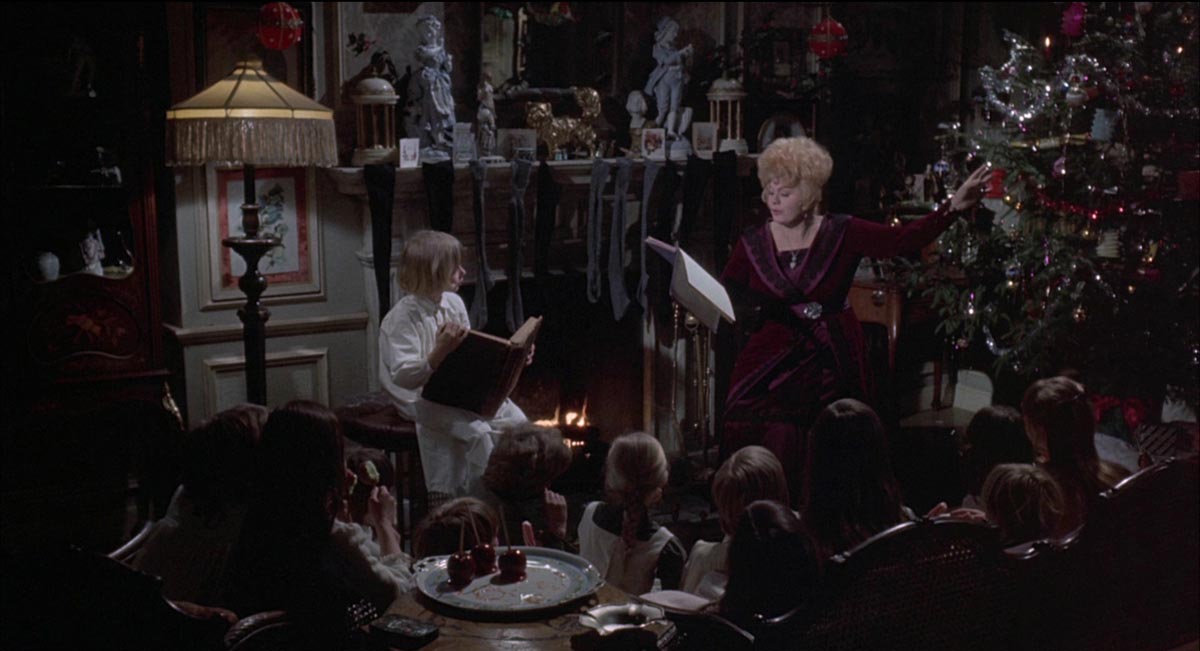
With Whoever Slew Auntie Roo?, Harrington delves into this aging, strange, sad woman and two strange, sad children who enter her life with scares not always coming from crazy Roo. The woman can’t let go of her tragic past, she can’t stand to be alone, and the children, chiefly the brother, wants to keep his sister to himself. In his typically esoteric and compelling way, Harrington updated the “Hansel and Gretel” story wherein the mean lonely witch isn’t always so mean, and the nice abandoned kids aren’t always so nice. It’s a fascinating way to tell the story – with so many shadings – it’s never that simple.
The meaner kid (though that’s too easy a word to describe him) is orphan Christopher Coombs (Mark Lester), who has a vivid imagination, enough to frighten the other children at the orphanage where lives he with this little sister, Katy (Chloe Franks). He’s close to his sister, and he looks out for her, but he’s an odd child. He seems a bit… obsessed with her. But like obsessive Auntie Roo, he doesn’t want to be alone (though he would never believe he had anything in common with that woman). Every year a handful of the most well-behaved kids in the orphanage are allowed to spend Christmas at Auntie Roo’s impressive gingerbread-looking house, only Christopher and Katy are punished (for Christopher’s willful imagination), and not allowed to attend. But they sneak in anyway. They’re discovered and reprimanded, but sweet-psycho Roo accepts them – chiefly because she thinks she recognizes her deceased daughter Katherine in young Katy. Could she be? And if not, perhaps she can make her be. This is when things start going even nuttier.
Auntie Roo is charitable with the all of the kids – she throws them a lavish Christmas morning complete with loads of presents under the gorgeous tree. What orphan wouldn’t want to spend the holidays with Auntie Roo? She even sings a song and dances for them— to Gilbert and Sullivan’s “Tit Willow.” But Christopher is suspicious – he sees Katy and himself as a version of Hansel and Gretel and this woman is going to keep them, fatten them up, maybe even eat them. It’s a unique device – Christopher imagining and narrating in his head these scenarios of Roo being a witch. He even climbs into her dumbwaiter and spies on her – she’s singing “Let No Many Steal Your Thyme,” and he witnesses Roo placing her daughter’s corpse in a small coffin, wearing all black and a black veil. Well, that is something. His imagination doesn’t seem so mischievous or wrong at this point – and it’s not. Auntie Roo may not be a witch, but she’s certainly alarming. But no one is going to listen to Christopher because, like the eye-rolling a “daffy” older lady often gets, many people don’t respect children, or believe them. With that, Roo and Christopher are somewhat united, and this is part of the picture’s complicated magic.
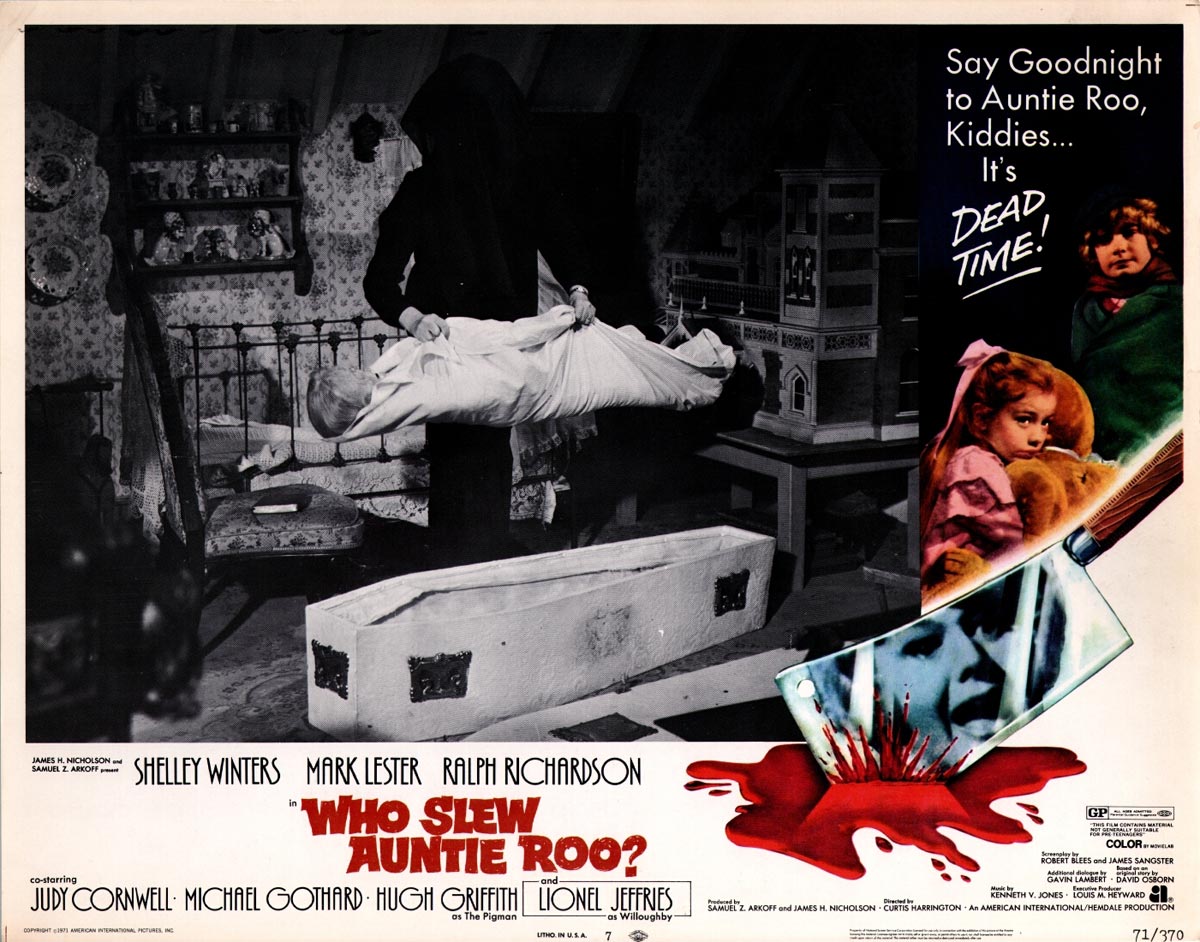
What I love here is that cultured, innovative, cineaste Curtis Harrington (his entire life was fascinating) – shows such respect and even reverence for certain actors (and all kinds of artists), and actresses in more specific cases, that he understood them for being beautiful, odd-looking and even fading. In older actresses, particularly movie stars, he still saw and appreciated their charisma. From his adoration of Marlene Dietrich (and her mentor, Josef Von Sternberg, of which Harrington wrote a monograph of in the 1950s), to Simone Signoret (whom he worked with in Games and spoke highly of his entire life – she warned him that she was “fat” before starting the picture), to Gloria Swanson (his star of the TV movie Killer Bees, of which he said: “Gloria showed only love and acceptance toward the bees as we poured them on her skin. Kate Jackson, on the other hand, shuddered and was repelled by them.”), to Bette Davis, whom he wanted to work with, and many others. Harrington found these older actresses vital, still interesting, still stars. And in this picture, he allowed Winters a little more depth than a casual moviegoer might expect from a movie within this genre – although, as said, these actresses always gave a lot within the Grande Dame Guignol.
And he allowed her to be something many can relate to – lonely. Not just pathetic, not just silly or scary, but lonely. Yes, she’s frightening, she’s even funny at times, but she’s grieving and she’s going insane. But Harrington isn’t exploiting this predicament for laughs or easy terror, just as he wasn’t with his fantastic What’s the Matter with Helen? (another one of the greats in the genre Grande Dame Guignol) featuring stellar performances by Winters and Debbie Reynolds (who looked gorgeous). Watching Winters end that picture playing “Goody-Goody” on the piano – with that madness, desperation and sadness in her smile, is truly haunting and incredibly sad. It’s one of Harrington’s greatest pictures among such interesting work, and he really got Winters, no matter how much off-screen drama occurred with the actress.
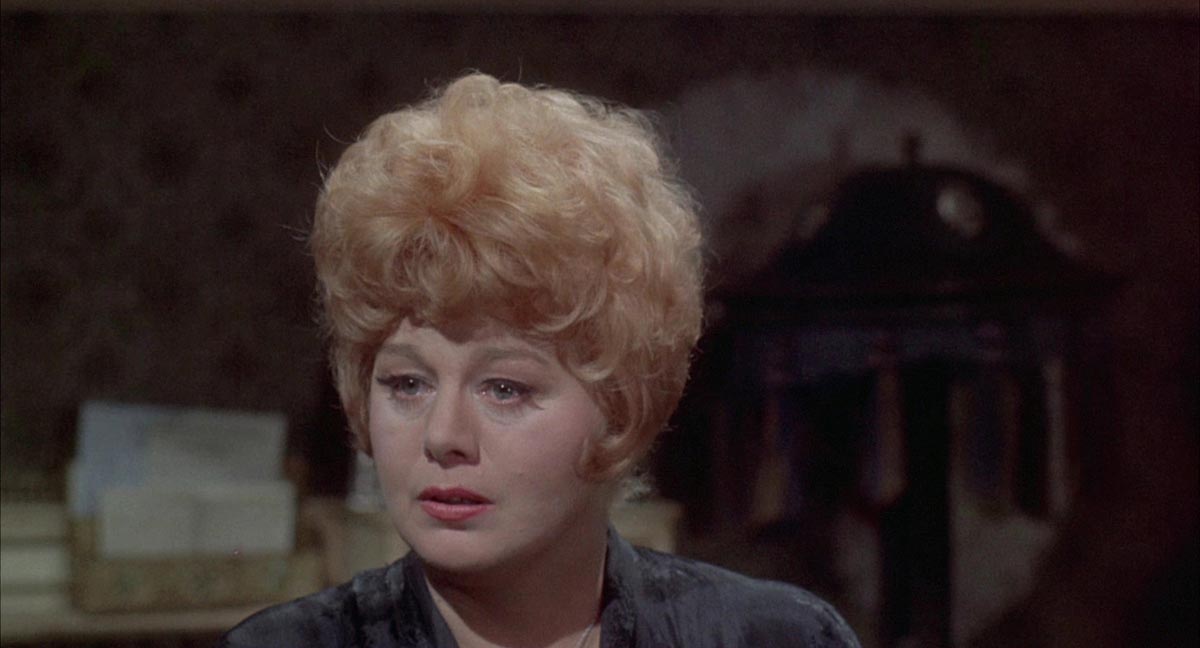
Here’s how much he got actresses/movie stars: In his excellent autobiography, “Nice Guys Don’t Work in Hollywood,” he wrote a lovely recollection from the time he was working with Jerry Wald, after he’d directed his avant-garde short films and before his hauntingly beautiful Night Tide was made. One day, he took in the astounding star appeal of Joan Crawford. Harrington talks of watching dailies of an older Crawford in Robert Aldrich’s masterful Autumn Leaves, which he called a “revelation”:
“For the first time, I became aware of what the term ‘movie star’ means. The word ‘star’ in the context of a top movie personality is very appropriate, since astronomically speaking, a star is a body that is illuminated from within. This illumination from within is what I witnessed that day in a projection room at Columbia Studios. The shoot had taken place during the summer. The camera was set on a close-up of Joan Crawford between takes, looking very wilted and ordinary, fanning herself in the heat. Then the clapboard was thrust in front of her, the clapper lowered, and a voice said, ‘Scene eighty-four, take three.’ In that split second, I witnessed an ordinary, exhausted woman center all of her energies and come vibrantly alive as Joan Crawford, the Movie Star. It was a metaphysical experience.”
Metaphysical. I’m not sure he felt this strongly about Shelley Winters – she was never Joan Crawford – but he understood Winters’ power and star quality and unique neediness. And he understood her pathos. As Roo holds a séance conducted by fake psychic Mr. Benton (a great Ralph Richardson) with Auntie Roo’s shifty, psychopathic butler Albie (a creepy Michael Gothard) included – they have been tricking her – and you hate them for it. You don’t laugh at her, you realize what awful people are exploiting her. One of the servants, Clarine (Judy Cornwall), is providing the ghostly voice of Roo’s dead daughter, making Roo hold on to hope even more, and Benton to rake in even more dough, that bastard. They’re so unscrupulous, such scumbags, that they don’t feel a thing when a beseeching Roo hollers out for her child: “Oh, Katharine stay! Stay my darling. Please forgive me! Forgive me! Give me another chance! I love you so much! Oh, Katherine! I need you, stay with me! I’m so lonely, stay with… Katherine!!”
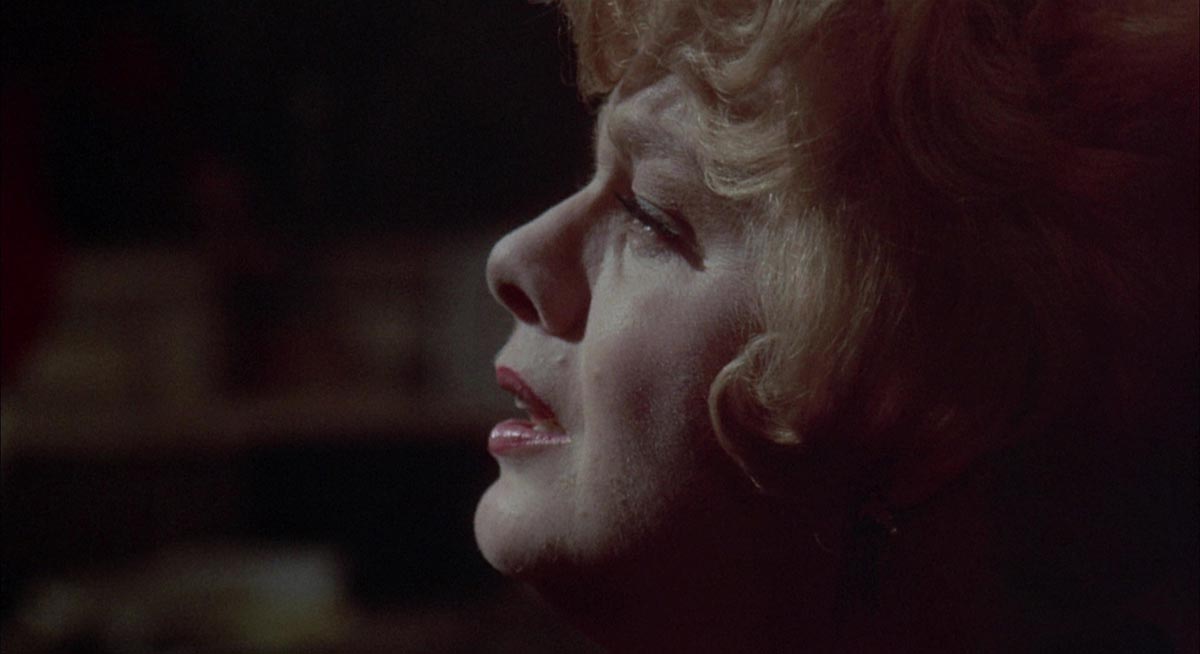
Dear lord. It’s an intense scene – Shelley howling her desolation (she does this a lot throughput the movie, horrifying and sometimes darkly funny). But after this outcry, the picture does a quick, smart cut to Katy shot from outside of a doleful window at the orphanage, from which she is staring into the grey and depressing landscape. Katy doesn’t know it yet, but she will become Roo’s obsession, and the picture hints that perhaps she is some kind of reincarnation of Roo’s dead daughter. And, so, after Auntie Roo’s Christmas get together is over, Roo really does snatch Katy. Christopher was right in his worry and, yet, you still don’t like him all that much. He’s always scaring people, his sister included, and he doesn’t seem like a good influence on her mental state. He manages to break back into Roo’s house to “save” his sister and I always think, maybe Katy would be better off with Auntie Roo. And, indeed, at one point, Katy does tell her brother that she’d rather live with Roo.
Christopher is having none of this and plans their escape while stuffing Roo’s jewels in the back of the teddy bear (reminiscent of Pearl’s doll in Night of the Hunter), Roo gave to Katy (it was her daughter’s before, and the stuffed animal even sits at the séance). But the kids are soon caught and then stuck with Auntie Roo – enduring her combination of creepy sweetness (some of it genuine, some I don’t know what the hell she’s doing) and horror (watching Christopher watch Roo eating is something else – hilarious and bizarre). Christopher has had to survive, and you can’t blame the kid for being hardened and crafty and even a liar and a thief – but there’s a gleam in his eye whenever he sets to antagonizing Auntie Roo, and it looks murderous. Like you can see it – that his future will lead to violence and sociopathy. Though he certainly hates Roo for a solid reason (kidnapping), and he really, truly views her as a witch (he takes his fairy tales seriously, but then perhaps, he takes them seriously when convenient), you feel his fairy tale also fits his purpose of destroying someone. Burn the witch!
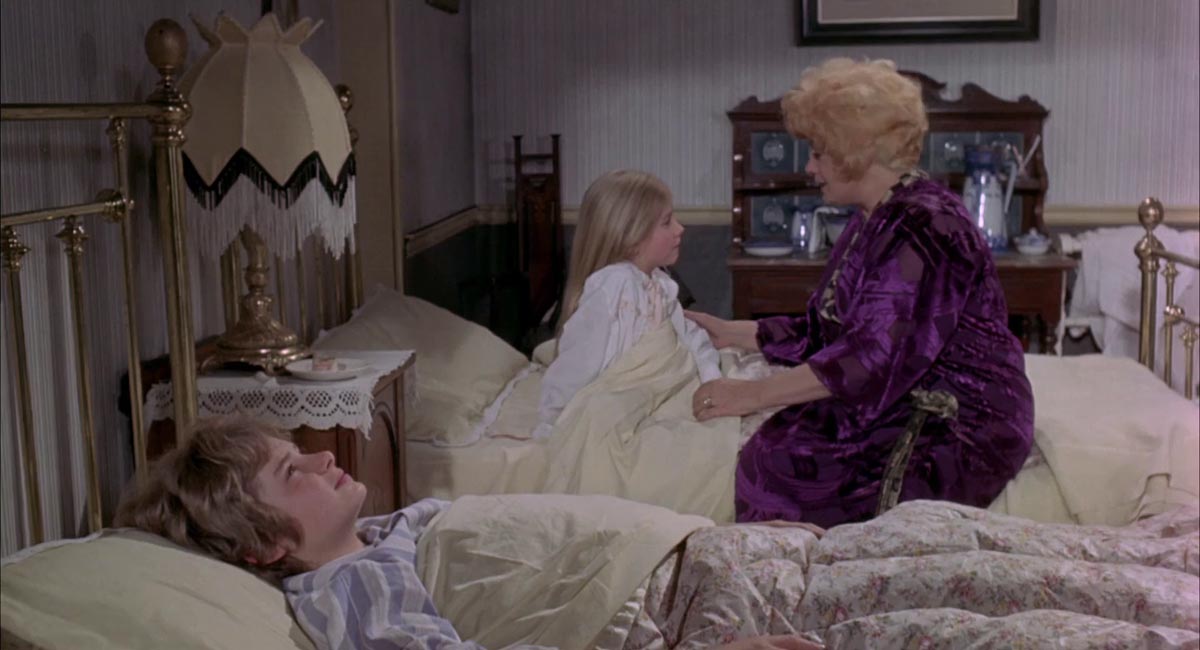
You can feel the rot in this kid and Lester plays Christopher with such mystery and contempt that the horror shifts – who are we rooting for here? We should be hoping the kids are free but… we don’t want to see Auntie Roo obliterated. I don’t, anyway. And though these kids must escape, he and Katy take to some drastic, cruel measures to get the hell out of there: they lock Roo in a room and set it on fire. Yes, they burn poor Auntie Roo to death – and that lovely gingerbread house goes up in flames. Whoever Slew? Now we know. But no one else in the movie does.
When Dr. Mason (Pat Heywood) understands what the children have been through, he says: “Poor little devils, they’ll probably have nightmares till the day they die.” Maybe they will. Maybe. Christopher, with his refrain of the story of “Hansel and Gretel,” closes out the movie with this: “Hansel and Gretel knew that the wicked witch could not harm anyone else and they were happy. They also knew that with the wicked witch’s treasure they would not be hungry again. So, they lived happily ever after.”
Well, I suppose. But I kind of despise Christopher for torching Auntie Roo. And this will sound wrong, but I do hope he wakes up to one of those nightmares Dr. Mason reckons will occur. Chiefly, one of Auntie Roo, or rather, Shelley Winters, standing there in that gown and gloves and tiara and mummified corpse child, singing softly:
Beware, beware keep your garden fair. Let no man steal your thyme; Let no man steal your thyme. For when your thyme is past and gone, he’ll care no more for you, and every place where your thyme was waste, will all spread o’re with rue, will all spread o’re with rue.
And I hope it happens on Christmas. A Grand Dame Guignol Christmas.


